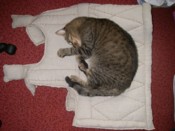Jacquemart Gielee’s Renart le Nouvel: The Image of the Military Orders on the Eve of the Loss of Acre
By Helen Nicholson
Monastic Studies: The Continuity of Tradition, ed. J. Loades (1990)
Introduction: In this paper I shall be discussing the image of two monastic orders at a crucial point in their history, as revealed by a contemporary satire.
The military order was a unique development of the monastic ideal, a response to the need of the armed forces to defend Christian pilgrims in the Latin kingdom of Jerusalem from attack by Muslim bandits. Many such orders were founded for this purpose between the capture of Jerusalem by the first crusade in 1099 and the loss of the last capital of the kingdom, Acre, in 1291, but the most famous and most important were the order of the Temple of Soloman, the Hospital of St John, and the Teutonic Order.
The question of their image is of great importance, for two main reasons. Firstly, the trial and abolition in the early fourteenth century of the order of the Temple has often been attributed to its unpopularity. The survival of the other military orders would therefore imply that Temple was the most unpopular order, but this is yet to be established. Secondly, recent instigation into attitudes towards crusading during the thirteenth century have demonstrated that the crusade did not, as was previously thought, decline in popularity during this period and that in fact crusading continued to attract support long after the loss of Acre. Since the military orders, as defenders of the Holy Land, were an integral part of the crusading movement, changes in their image shed valuable light on attitudes towards crusading.
In a study of opinions and attitudes, literary sources offer a rich mind of evidence. The difficulties and dangers of using material as historical evidence have often been discussed. However, all historical evidence must be assessed according to its own restrictions, and, as an increasing number of historians are demonstrating, a study of literary sources can open hitherto undreamt-of paths of investigation. In the case of Renart le Nouvel, the literary source both endorses the evidence of chronicles and documents and throws into the relief aspects which might otherwise have been dismissed.
http://www.medievalists.net/files/09092709.pdf
Military Orders on the Eve of the Loss of Acre
Modérateur : L'équipe des gentils modos
Grég le furet
56
Miles britto-romain an 5OO.
Letavia <a href="http://letavia.canalblog.com/" target="_blank">http://letavia.canalblog.com/</a>
56
Miles britto-romain an 5OO.
Letavia <a href="http://letavia.canalblog.com/" target="_blank">http://letavia.canalblog.com/</a>
-
thibaut de brabant
- Messages : 1271
- Enregistré le : jeu. août 06, 2009 11:00 pm
- Localisation : Lyon
Merci
"Si j'avance, suivez-moi ;
Si je meurs, vengez-moi ;
Si je recule, tuez-moi."
Henri de la Rochejaquelein
Si je meurs, vengez-moi ;
Si je recule, tuez-moi."
Henri de la Rochejaquelein

